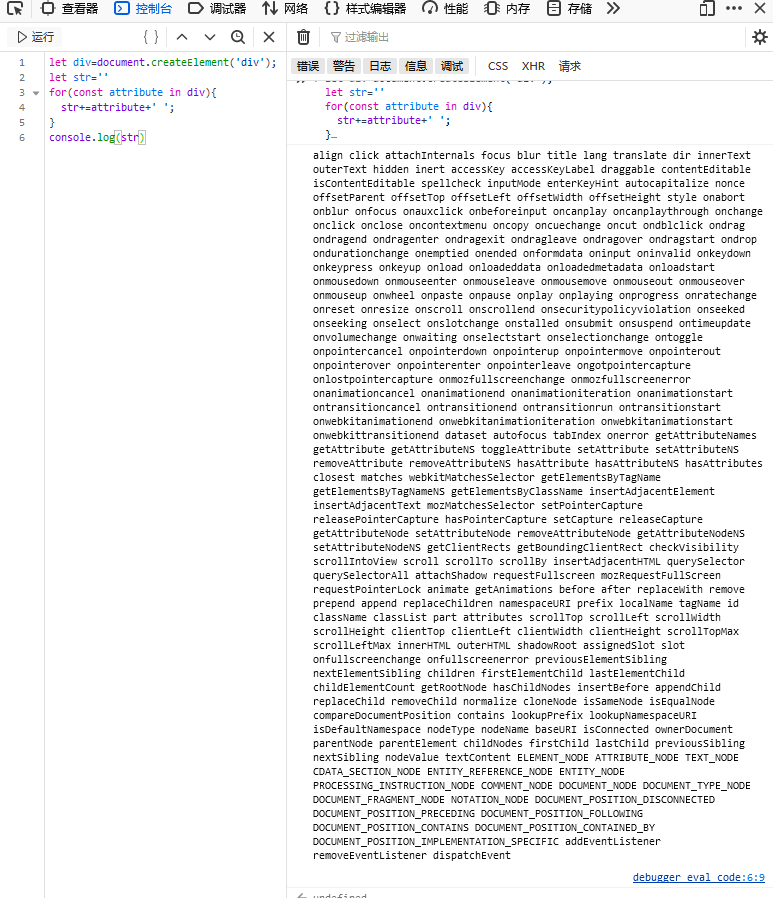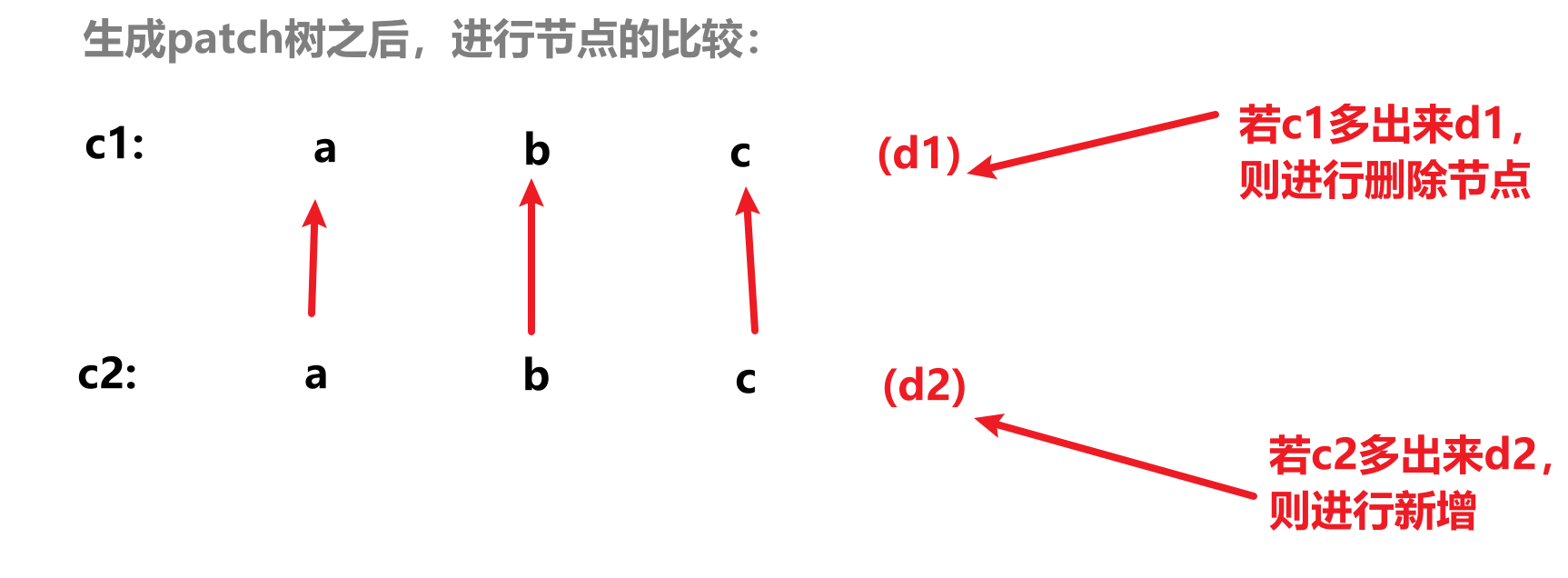Vue核心虚拟DOM和diff算法
虚拟DOM
原因
之所以需要虚拟dom,是因为一个元素含有许多的属性(如下图)且每次更新需要重新计算布局(计算每个元素的位置和大小)和绘制(将元素绘制在屏幕上),直接操作DOM的话性能会偏低,这时候我们就可以用js的计算性能(也就是通过diff算法)来换取操作DOM所消耗的性能,操作js是非常快的。

工作流程
- 创建虚拟DOM节点:Vue使用JavaScript对象来表示虚拟DOM节点,每个虚拟DOM节点都代表一个真实的DOM节点。
- 构建虚拟DOM树:将所有虚拟DOM节点组合成一个虚拟DOM树。
- 渲染虚拟DOM:将虚拟DOM树渲染到屏幕上。
- 更新虚拟DOM:当应用程序的状态发生变化时,Vue会创建一个新的虚拟DOM树。
- 比较新旧虚拟DOM树:Vue会将新的虚拟DOM树与旧的虚拟DOM树进行比较,以找出需要更新的部分。这个过程被称为“diff” 算法。
- 更新真实的DOM:Vue会将需要更新的部分转换为真实的DOM操作,并且应用到真实的DOM节点上,从而更新应用程序的UI。
vnode节点
Vue3中用于创建VNode的函数createVNode接受三个参数:标签名、属性对象和子节点。通过调用此函数,我们可以创建一个虚拟DOM节点。
例如,如果我们想创建一个<div>标签的虚拟DOM节点,可以使用如下代码:
typescript
const vnode = createVNode('div', { class: 'container' }, 'Hello, Vue 3!');在这个例子中,函数的第一个参数是'div',表示要创建一个<div>标签的虚拟DOM节点。第二个参数是一个属性对象,用于设置class属性为'container'。第三个参数是子节点,这里是一个文本节点‘Hello, Vue 3!’。
没有key 的diff算法
看Vue3源码:
typescript
// 没有key的diff算法
const patchUnkeyedChildren = (
c1: VNode[],//旧的虚拟DOM
c2: VNodeArrayChildren,//新的虚拟DOM
container: RendererElement,
anchor: RendererNode | null,
parentComponent: ComponentInternalInstance | null,
parentSuspense: SuspenseBoundary | null,
isSVG: boolean,
slotScopeIds: string[] | null,
optimized: boolean
) => {
c1 = c1 || EMPTY_ARR
c2 = c2 || EMPTY_ARR
const oldLength = c1.length
const newLength = c2.length
const commonLength = Math.min(oldLength, newLength)
let i
//通过下面这个for循环进行生成Patch树,Patch树的每个节点表示一次DOM操作
for (i = 0; i < commonLength; i++) {
const nextChild = (c2[i] = optimized
? cloneIfMounted(c2[i] as VNode)
: normalizeVNode(c2[i]))
patch(
c1[i],
nextChild,
container,
null,
parentComponent,
parentSuspense,
isSVG,
slotScopeIds,
optimized
)
}
if (oldLength > newLength) {
// 当旧节点数大于新节点数时,就把旧节点给删除
// remove old,删除旧节点
unmountChildren(
c1,
parentComponent,
parentSuspense,
true,
false,
commonLength
)
} else {
// 当旧节点数小于新节点数时,就新增节点
// mount new,增加新节点
mountChildren(
c2,
container,
anchor,
parentComponent,
parentSuspense,
isSVG,
slotScopeIds,
optimized,
commonLength
)
}
}
有key 的diff算法
看vue3源代码:
typescript
// 有key的diff算法
// can be all-keyed or mixed
const patchKeyedChildren = (
c1: VNode[],//旧的虚拟DOM
c2: VNodeArrayChildren,//新的虚拟DOM
container: RendererElement,
parentAnchor: RendererNode | null,
parentComponent: ComponentInternalInstance | null,
parentSuspense: SuspenseBoundary | null,
isSVG: boolean,
slotScopeIds: string[] | null,
optimized: boolean
) => {
let i = 0
const l2 = c2.length
let e1 = c1.length - 1 // prev ending index
let e2 = l2 - 1 // next ending index
// 前序对比算法,新旧虚拟DOM(n1和n2)进行头和头对比
// 1. sync from start
// (a b) c
// (a b) d e
while (i <= e1 && i <= e2) {
const n1 = c1[i]//将c1按序赋值给n1
//将c2赋值给n2,
// 如果optimized为真,它会使用VNode对象强制转换c2[i]作为参数调用cloneIfMounted函数,这个函数会进而调用cloneVNode函数,并将结果赋值给c2[i]。
// 如果optimized为假,则使用c2[i]作为参数调用normalizeVNode函数,这个函数会进而调用createVNode函数,并将结果赋值给c2[i]。
const n2 = (c2[i] = optimized
? cloneIfMounted(c2[i] as VNode)
: normalizeVNode(c2[i]))
// 比对两个VNode的类型以及key,Type指的是标签名,key指的是唯一标识,不相同的话直接break,
if (isSameVNodeType(n1, n2)) {
patch(
n1,
n2,
container,
null,
parentComponent,
parentSuspense,
isSVG,
slotScopeIds,
optimized
)
} else {
break
}
i++
}
// 尾序对比算法,尾和尾对比,跟vue2双端diff算法的区别在于vue2还会进行头尾交叉对比
// 2. sync from end
// a (b c)
// d e (b c)
while (i <= e1 && i <= e2) {
const n1 = c1[e1]
const n2 = (c2[e2] = optimized
? cloneIfMounted(c2[e2] as VNode)
: normalizeVNode(c2[e2]))
if (isSameVNodeType(n1, n2)) {
patch(
n1,
n2,
container,
null,
parentComponent,
parentSuspense,
isSVG,
slotScopeIds,
optimized
)
} else {
break
}
e1--
e2--
}
// 前面对比完后,发现有多余的节点,就进行新增
// 3. common sequence + mount
// (a b)
// (a b) c
// i = 2, e1 = 1, e2 = 2
// (a b)
// c (a b)
// i = 0, e1 = -1, e2 = 0
if (i > e1) {
if (i <= e2) {
const nextPos = e2 + 1
const anchor = nextPos < l2 ? (c2[nextPos] as VNode).el : parentAnchor
while (i <= e2) {
patch(
null,
(c2[i] = optimized
? cloneIfMounted(c2[i] as VNode)
: normalizeVNode(c2[i])),
container,
anchor,
parentComponent,
parentSuspense,
isSVG,
slotScopeIds,
optimized
)
i++
}
}
}
// 发现少了,就进行删除
// 4. common sequence + unmount
// (a b) c
// (a b)
// i = 2, e1 = 2, e2 = 1
// a (b c)
// (b c)
// i = 0, e1 = 0, e2 = -1
else if (i > e2) {
while (i <= e1) {
unmount(c1[i], parentComponent, parentSuspense, true)
i++
}
}
// 乱序情况下的比对
// 5. unknown sequence
// [i ... e1 + 1]: a b [c d e] f g
// [i ... e2 + 1]: a b [e d c h] f g
// i = 2, e1 = 4, e2 = 5
// i即为乱序数组([c d e]或[e d c h])第一个值在原数组(a b [c d e] f g或a b [e d c h] f g)的索引,
// 这里的e1(旧虚拟节点)为乱序数组最后一个值在原数组的索引,e2(新虚拟节点)为为乱序数组最后一个值在原数组的索引
else {
const s1 = i // prev starting index
const s2 = i // next starting index
// 5.1 build key:index map for newChildren
const keyToNewIndexMap: Map<string | number | symbol, number> = new Map()
for (i = s2; i <= e2; i++) {
const nextChild = (c2[i] = optimized
? cloneIfMounted(c2[i] as VNode)
: normalizeVNode(c2[i]))
if (nextChild.key != null) {
if (__DEV__ && keyToNewIndexMap.has(nextChild.key)) {
warn(
`Duplicate keys found during update:`,
JSON.stringify(nextChild.key),
`Make sure keys are unique.`
)
}
keyToNewIndexMap.set(nextChild.key, i)
}
}
// 5.2 loop through old children left to be patched and try to patch
// matching nodes & remove nodes that are no longer present
let j
let patched = 0
const toBePatched = e2 - s2 + 1
let moved = false
// used to track whether any node has moved
let maxNewIndexSoFar = 0
// works as Map<newIndex, oldIndex>
// Note that oldIndex is offset by +1
// and oldIndex = 0 is a special value indicating the new node has
// no corresponding old node.
// used for determining longest stable subsequence
// 记录新节点在旧节点中的位置数组
const newIndexToOldIndexMap = new Array(toBePatched)
for (i = 0; i < toBePatched; i++) newIndexToOldIndexMap[i] = 0
for (i = s1; i <= e1; i++) {
const prevChild = c1[i]
if (patched >= toBePatched) {
// all new children have been patched so this can only be a removal
// 有多余旧节点就进行删除
unmount(prevChild, parentComponent, parentSuspense, true)
continue
}
let newIndex
if (prevChild.key != null) {
newIndex = keyToNewIndexMap.get(prevChild.key)
} else {
// key-less node, try to locate a key-less node of the same type
for (j = s2; j <= e2; j++) {
if (
newIndexToOldIndexMap[j - s2] === 0 &&
isSameVNodeType(prevChild, c2[j] as VNode)
) {
newIndex = j
break
}
}
}
// 新节点不包含在旧节点中也进行删除
if (newIndex === undefined) {
unmount(prevChild, parentComponent, parentSuspense, true)
} else {
newIndexToOldIndexMap[newIndex - s2] = i + 1
if (newIndex >= maxNewIndexSoFar) {
maxNewIndexSoFar = newIndex
} else {
// 节点出现交叉,moved为true,说明是要移动的,去求新旧子树的最长递增子序列,在5.3中,根据moved的值,调用getSequence函数
moved = true
}
patch(
prevChild,
c2[newIndex] as VNode,
container,
null,
parentComponent,
parentSuspense,
isSVG,
slotScopeIds,
optimized
)
patched++
}
}
// 5.3 move and mount
// generate longest stable subsequence only when nodes have moved
// 求最长递增子序列升序
const increasingNewIndexSequence = moved
? getSequence(newIndexToOldIndexMap)
: EMPTY_ARR
j = increasingNewIndexSequence.length - 1
// looping backwards so that we can use last patched node as anchor
for (i = toBePatched - 1; i >= 0; i--) {
const nextIndex = s2 + i
const nextChild = c2[nextIndex] as VNode
const anchor =
nextIndex + 1 < l2 ? (c2[nextIndex + 1] as VNode).el : parentAnchor
if (newIndexToOldIndexMap[i] === 0) {
// mount new
patch(
null,
nextChild,
container,
anchor,
parentComponent,
parentSuspense,
isSVG,
slotScopeIds,
optimized
)
} else if (moved) {
// move if:
// There is no stable subsequence (e.g. a reverse)
// OR current node is not among the stable sequence
// 如果当前遍历的这个节点 不在 子序列说明要进行移动
if (j < 0 || i !== increasingNewIndexSequence[j]) {
move(nextChild, container, anchor, MoveType.REORDER)
} else {
// 如果节点在序列中直接跳过
j--
}
}
}
}
}赋值给新虚拟节点时使用的函数
看vue3源代码:
typescript
export function normalizeVNode(child: VNodeChild): VNode {
if (child == null || typeof child === 'boolean') {
// empty placeholder
return createVNode(Comment)
} else if (isArray(child)) {
// fragment
return createVNode(
Fragment,
null,
// #3666, avoid reference pollution when reusing vnode
child.slice()
)
} else if (typeof child === 'object') {
// already vnode, this should be the most common since compiled templates
// always produce all-vnode children arrays
return cloneIfMounted(child)
} else {
// strings and numbers
return createVNode(Text, null, String(child))
}
}
// optimized normalization for template-compiled render fns
export function cloneIfMounted(child: VNode): VNode {
return (child.el === null && child.patchFlag !== PatchFlags.HOISTED) ||
child.memo
? child
: cloneVNode(child)
}最长递增子序列
最长递增子序列目的是在一个给定的数值序列中,找到一个子序列,使得这个子序列元素的数值依次递增,并且这个子序列的长度尽可能地大,算法示例执行过程,在vue3中传入新节点在旧节点的位置数组至以下函数,获取到升序的递增子序列(由乱序转为有序),看vue3源代码:
typescript
// [https://en.wikipedia.org/wiki/Longest_increasing_subsequence](https://en.wikipedia.org/wiki/Longest_increasing_subsequence)
// 贪心+二分,最长递增子序列算法,即找到最长的升序子序列
function getSequence(arr: number[]): number[] {
const p = arr.slice()
const result = [0]
let i, j, u, v, c
const len = arr.length
for (i = 0; i < len; i++) {
const arrI = arr[i]
if (arrI !== 0) {
j = result[result.length - 1]
if (arr[j] < arrI) {
p[i] = j
result.push(i)
continue
}
u = 0
v = result.length - 1
while (u < v) {
c = (u + v) >> 1
if (arr[result[c]] < arrI) {
u = c + 1
} else {
v = c
}
}
if (arrI < arr[result[u]]) {
if (u > 0) {
p[i] = result[u - 1]
}
result[u] = i
}
}
}
u = result.length
v = result[u - 1]
while (u-- > 0) {
result[u] = v
v = p[v]
}
return result
}练习最长递增子序列
可以前往LeetCode练习用代码怎么写出最长递增子序列:
